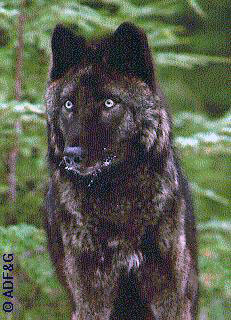July 25, 2015
Saturday
Environmental groups on Thursday asked three state and federal agencies to take decisive action to save what they say are the rapidly dwindling population of Alexander Archipelago wolves in the Prince of Wales Island area in Alaska’s Tongass National Forest.
 Photo courtesy ADF&G |
Following up on a June report by the Alaska Department of Fish and Game indicating that the wolf population in the area is alarmingly low, the environmental groups asked Alaska Fish and Game and the Federal Subsistence Board to cancel the area’s 2015-2016 trapping and hunting season. They also asked the U.S. Forest Service to suspend logging and road-building in its Big Thorne timber sale on Prince of Wales Island and to prepare a supplemental environmental impact statement for the project to reconsider impacts to wolves.
“Alexander Archipelago wolves are an essential piece of what makes our little corner of Alaska so special,” said Hunter McIntosh, president of The Boat Company, an ecotourism company based in Southeast Alaska. “The opportunity to see these unique wolves in their old growth home draws people from all over the world. Killing off our wolves is bad business and bad stewardship.”
These groups assert the Alexander Archipelago wolves are a subspecies of gray wolves that den in the roots of old-growth trees in the Tongass National Forest in Southeast Alaska. The U.S. Fish and Wildlife Service reported in 2014 found that protecting Alexander Archipelago wolves under the Endangered Species Act “may be warranted". The U.S. Fish and Wildlife Service will decide whether to list the wolves under the Act by the end of this year. In the 1990s Prince of Wales Island was home to about one-third of all Alexander Archipelago wolves before the island’s population declined. Wolves on the island are genetically distinct and geographically isolated from the rest of the subspecies say concerned environmental groups.
“Alexander Archipelago wolves are one-of-a-kind, and once they’re gone, they’re not coming back,” said Rebecca Noblin, Alaska director of the Center for Biological Diversity. “We have to protect the few remaining wolves on Prince of Wales Island right now, or they’ll be gone before the government can even decide whether they need Endangered Species Act protection.”
Alaska Fish and Game’s report estimated that the wolf population on and around Prince of Wales in fall 2014 was between 50 and 159, and most likely about 89 wolves, down from an estimated population of 250 to 350 in the mid-1990s. The report also stated that females have been reduced to only 25 percent of the dwindling population, posing a clear obstacle to the wolves’ ability to recover from their decline. The 2014 estimate does not account for the 29 wolves reported taken in the 2014/2015 winter trapping season, nor does it account for any illegal takes during that time or since, which studies indicate may be substantial.
The groups asked both the state and federal government to cancel the 2015/2016 hunting and trapping season in order to prevent extirpation of the wolves on Prince of Wales Island. They also asked the U.S. Forest Service to halt the Big Thorne timber project, which threatens to destroy large swaths of essential Prince of Wales habitat for Alexander Archipelago wolves and their primary prey, Sitka black-tailed deer. The Big Thorne project will also create new logging roads, increasing human access and the associated hunting and trapping pressure on wolf populations.
“This is clearly an emergency — wolves are falling at an alarming rate on Prince of Wales Island, and it has to stop immediately,” said Larry Edwards, Greenpeace forest campaigner in Sitka. “But the long-term solution to the wolves’ peril is to stop old-growth logging in the Tongass National Forest to preserve the last remaining big trees that wolves and so many other animals need. Without an end to old-growth logging, no amount of hunting regulations, alone, can save the wolves.”
Edited by Mary Kauffman, SitNews
Related Information:
The Alexander Archipelago Wolf: A Conservation Assessment
http://www.adfg.alaska.gov/index.cfm?adfg=wolf.aawolf
Alexander Archipelago wolf listing as "endangered or threatened may be warranted" says USFWS By MARY KAUFFMAN - The U.S. Fish and Wildlife Service announced Friday that Alaska's Alexander Archipelago wolves may need protection under the Endangered Species Act because of unsustainable logging in the Tongass National Forest and elsewhere in southeast Alaska. The agency will now conduct an in-depth status review of what conservationists call a "rare subspecies" of gray wolf, which lives only in the region's old-growth forests. - More...
SitNews - March 29, 2014
Wolf Population on Prince of Wales Island Crashes - State and federal authorities are reporting a “dramatic decline in the wolf population on Prince of Wales Island, Tongass National Forest.” A new report records a 60 percent drop in the number of Alexander Archipelago wolves in just one year, reinforcing conservationists’ arguments that plans to log old-growth forests on the island should be halted to protect the wolf and other wildlife. - More...
SitNews - June 08, 2015
Source of News:
Cascadia Wildlandssource
www.cascwild.org
Center for Biological Diversity
www.biologicaldiversity.org/
Greater Southeast Alaska Conservation Community
www.gsacc.net/
Greenpeace - Sitka
www.greenpeace.org


No comments:
Post a Comment